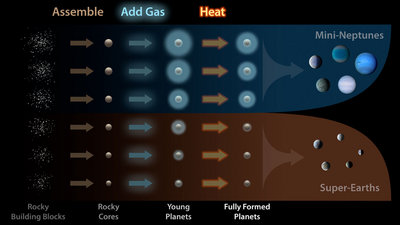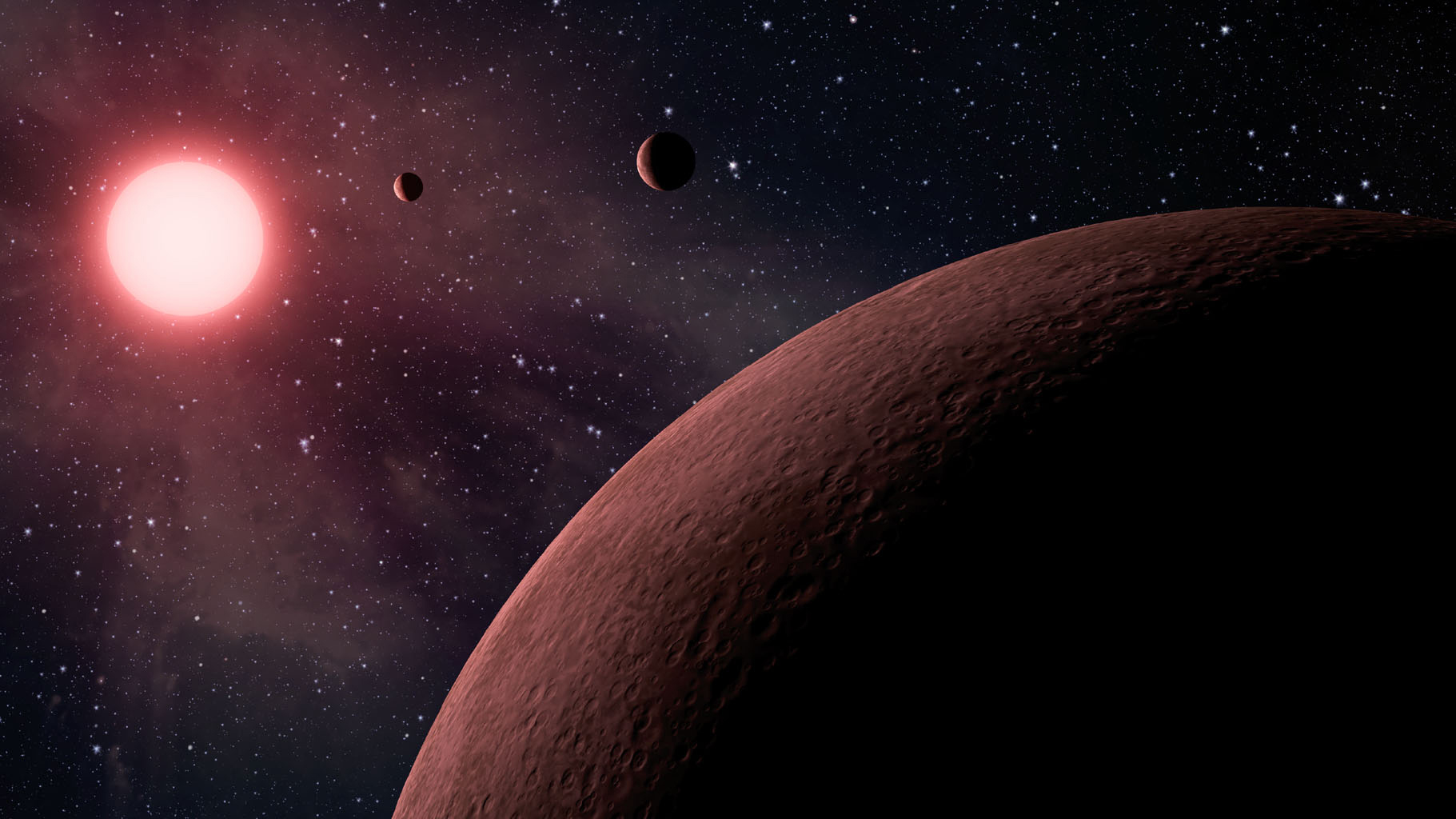Find out the latest thinking about our universe.
-
bystander
- Apathetic Retiree
- Posts: 21577
- Joined: Mon Aug 28, 2006 2:06 pm
- Location: Oklahoma
Post
by bystander » Mon Jun 19, 2017 8:06 pm
Kepler Survey Catalog Contains Hundreds of New Planet Candidates
NASA |
JPL-Caltech | Ames | Kepler | 2017 Jun 19
NASA's Kepler space telescope team has released a mission catalog of planet candidates that introduces 219 new candidates, 10 of which are near-Earth size and orbiting in their star's habitable zone, which is the range of distance from a star where liquid water could pool on the surface of a rocky planet.
This is the most comprehensive and detailed catalog release of candidate exoplanets, which are planets outside our solar system, from Kepler's first four years of data. It's also the final catalog from the spacecraft's view of the patch of sky in the Cygnus constellation.
With the release of this catalog, derived from data publicly available on the
NASA Exoplanet Archive, there are now 4,034 planet candidates identified by Kepler. Of those, 2,335 have been verified as exoplanets. Of roughly 50 near-Earth size habitable zone candidates detected by Kepler, more than 30 have been verified.
Additionally, results using Kepler data suggest two distinct size groupings of small planets. Both results have significant implications for the search for life. The final Kepler catalog will serve as the foundation for more study to determine the prevalence and demographics of planets in the galaxy, while the discovery of the two distinct planetary populations shows that about half the planets we know of in the galaxy either have no surface, or lie beneath a deep, crushing atmosphere -- an environment unlikely to host life. ...
Know the quiet place within your heart and touch the rainbow of possibility; be
alive to the gentle breeze of communication, and please stop being such a jerk. — Garrison Keillor
-
bystander
- Apathetic Retiree
- Posts: 21577
- Joined: Mon Aug 28, 2006 2:06 pm
- Location: Oklahoma
Post
by bystander » Mon Jun 19, 2017 8:26 pm
New Branch in Family Tree of Exoplanets Discovered
California Institute of Technology | 2017 Jun 19
Researchers have classified exoplanets in the same way that biologists identify new animal species.
This diagram illustrates how planets are assembled and sorted into two
distinct size classes. First, the rocky cores of planets are formed from
smaller pieces. Then, the gravity of the planets attracts hydrogen and
helium gas. Finally, the planets are "baked" by the starlight and lose some
gas. At a certain mass threshold, planets retain the gas and become
gaseous mini-Neptunes; below this threshold, the planets lose all their
gas, becoming rocky super-Earths. Credit: NASA/Kepler/Caltech (R. Hurt)
Since the mid-1990s, when the first planet around another sun-like star was discovered, astronomers have been amassing what is now a large collection of exoplanets—nearly 3,500 have been confirmed so far. In a new Caltech-led study, researchers have classified these planets in much the same way that biologists identify new animal species and have learned that the majority of exoplanets found to date fall into two distinct size groups: rocky Earth-like planets and larger mini-Neptunes. The team used data from NASA's Kepler mission and the W. M. Keck Observatory.
"This is a major new division in the family tree of planets, analogous to discovering that mammals and lizards are distinct branches on the tree of life," says Andrew Howard ...
In essence, their research shows that our galaxy has a strong preference for two types of planets: rocky planets up to 1.75 times the size of Earth, and gas-enshrouded mini-Neptune worlds, which are from 2 to 3.5 times the size of Earth (or somewhat smaller than Neptune). Our galaxy rarely makes planets with sizes in between these two groups. ...
The California-Kepler Survey. III. A Gap in the Radius Distribution of Small Planets - Benjamin J. Fulton
et al
Know the quiet place within your heart and touch the rainbow of possibility; be
alive to the gentle breeze of communication, and please stop being such a jerk. — Garrison Keillor
-
hijikata
- Asternaut
- Posts: 6
- Joined: Wed Jun 21, 2017 10:51 am
Post
by hijikata » Wed Jun 21, 2017 11:06 am
For me is a very interesting information. I don't know anything about Super-Earths or Mini-Neptunes.
-
neufer
- Vacationer at Tralfamadore
- Posts: 18805
- Joined: Mon Jan 21, 2008 1:57 pm
- Location: Alexandria, Virginia
Post
by neufer » Wed Jun 21, 2017 11:48 am
George Carlin wrote:

This diagram illustrates how planets are assembled and sorted into two distinct size
classes. First, the rocky cores of planets are formed from smaller pieces. Then, the
gravity of the planets attracts hydrogen and helium gas. Finally, the planets are
"baked" by the starlight and lose some gas. At a certain mass threshold, planets
retain the gas and become gaseous mini-Neptunes; below this threshold, the planets
lose all their gas, becoming rocky super-Earths. Credit: NASA/Kepler/Caltech (R. Hurt)
Hi there folks. Welcome to the cooking show. A lot of you folks been writing in asking us “How do you cook them damn grits?” Well, we're gonna to show you today how you cook them damn grits.
First of all kinda get those grits down is a shallow sauce pan, kinda get a little water, about an inch and a halfa water above them grits. Get that thing boilin' good, get a good rollin' boil, a high rollin' boil, we call it a high rollin' boil. Get that thing goin' good then you're gonna drain them off a little bit, drain them off a little bit get a little steam out here, drain them off a little bit.
Get 'em down a little bit into moist little patties, get 'em down into moist little patties, two little fat little moist little patties. Put 'em in a hot skillet, a hot skillet with lots of hot grease, get 'em brown on one side, get 'em brown on the other side, and then throw 'em away! They're no good folks, you can't eat them damn grits.
Art Neuendorffer
-
bystander
- Apathetic Retiree
- Posts: 21577
- Joined: Mon Aug 28, 2006 2:06 pm
- Location: Oklahoma
Post
by bystander » Sun Jul 09, 2017 4:05 pm
Evidence Discovered for Two Distinct Giant Planet Populations
Institute of Astrophysics and Space Sciences (IA) | University of Porto | 2017 Jul 05
In a paper highlighted today by
Astronomy & Astrophysics journal, a team of researchers from the Instituto de Astrofísica e Ciências do Espaço (IA) discovered observational evidence for the existence of two distinct populations of giant planets.
So far, more than 3500 planets have been detected orbiting solar type stars. Although recent results suggest that most planets in our Galaxy are rocky like Earth, a large population of giant planets, with masses that can go up to 10 or 20 times the mass of Jupiter (itself 320 times the mass of the Earth), was also discovered.
A large amount of the information about how these planets are formed is coming from the analysis of the connection between the planets and their host star. Initial findings have shown, for example, that there is a tight connection between the metallicity4 of the star and the planet occurrence or frequency. Stellar mass has also been suggested to influence planet formation efficiency.
State-of the art models of planet formation suggest that two main avenues exist for the formation of gas giants. The so called core-accretion process says that first you form a rocky/icy core, and then this core draws gas around it, giving origin to a giant planet. The other suggests that instabilities in the protoplanetary disk5 can lead to the formation of gas clumps, which then contract to form a giant planet. ...
Observational evidence for two distinct giant planet populations - N. C. Santos
et al
Know the quiet place within your heart and touch the rainbow of possibility; be
alive to the gentle breeze of communication, and please stop being such a jerk. — Garrison Keillor
-
bystander
- Apathetic Retiree
- Posts: 21577
- Joined: Mon Aug 28, 2006 2:06 pm
- Location: Oklahoma
Post
by bystander » Sun Jul 09, 2017 7:03 pm
Cosmic Barbecue: Researchers Spot 60 New 'Hot Jupiter' Candidates
Yale University | 2017 Jul 06
Yale researchers have identified 60 potential new “hot Jupiters” — highly irradiated worlds that glow like coals on a barbecue grill and are found orbiting only 1% of Sun-like stars.
Hot Jupiters constitute a class of gas giant planets located so close to their parent stars that they take less than a week to complete an orbit.
Second-year Ph.D. student Sarah Millholland and astronomy professor Greg Laughlin identified the planet candidates via a novel application of big data techniques. They used a supervised machine learning algorithm — a sophisticated program that can be trained to recognize patterns in data and make predictions — to detect the tiny amplitude variations in observed light that result as an orbiting planet reflects rays of light from its host star.
“Sarah’s work has given us what amounts to a ‘class portrait’ of extrasolar planets at their most alien,” said Laughlin. “It’s amazing how the latest techniques in machine learning, compounded with high-performance computing, are allowing us to mine classic data sets for extraordinary discoveries.” ...
Supervised Learning Detection of Sixty Non-Transiting Hot Jupiter Candidates - Sarah Millholland, Gregory Laughlin
Know the quiet place within your heart and touch the rainbow of possibility; be
alive to the gentle breeze of communication, and please stop being such a jerk. — Garrison Keillor


